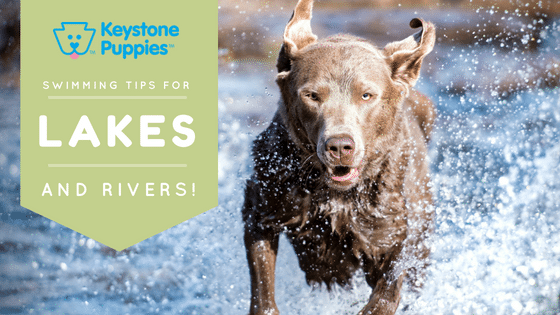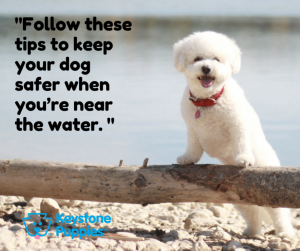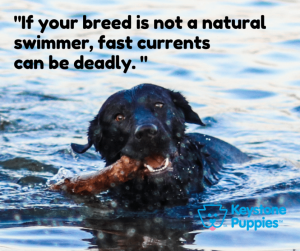Swimming in Lakes and Rivers with Dogs

Summer is here, and it’s a great time to cool off in local rivers and lakes. Many dogs love water, so you want to bring your dog along on your next outing to splash and swim.
Some breeds of dogs are natural swimmers, and crave time in the water, including Airedales, Portuguese Water Dogs, Golden Retrievers, Irish Setters, Labrador Retrievers, Newfoundlands, Standard Poodles, Chesapeake Bay Retrievers, Beagles, Vizslas, Cocker Spaniels, English Springer Spaniels, and German Shorthair Pointers. Other breeds vary in ability and willingness to swim. Take it slow with your pup, limiting him to very shallow water until you get a good sense of his natural ability and temperament around water. If your pup actively dislikes water, it may be a feature of his breeding. Don’t force your pup into the water.
Even for water-loving dogs, rivers and lakes present some challenges. Protect your puppy’s health and safety. Follow these tips to keep your dog safer when you’re near the water.

Tip #1: Leave Young Pups, Very old Dogs, and ill Dogs at Home
If your canine is younger than 14 weeks, very old and slow moving, or otherwise ill, keep him at home. These dogs may not be up to the physicality of swimming, and their immune systems are not strong. Young puppies, older dogs, and dogs with health issues are also less likely to be strong swimmers, and they will be more susceptible to bacteria and infections.
Tip #2: Avoid Water With Strong Currents

Being swept up in a current for the first time is a surprise for any dog. If your breed is not a natural swimmer, fast currents become even more dangerous. Play it safe, and limit swims to slow-moving rivers or calm pond or lakes. If you have a water breed that is an experienced swimmer, you can introduce currents gradually, slowly testing their ability to understand and navigate moving water. If you’re not sure if your puppy is ready for currents, use a doggy life jacket. The American Kennel Society shares more information on doggy life jackets here.
Tip #3: Stay Away From Stagnant Water
When the weather warms up, and the water level falls, rivers and lakes may become stagnant…and dangerous. Water stagnation happens when water stops flowing. Still water provides a perfect breeding ground for parasites and bacteria. If you encounter a pond, lake or creek that doesn’t appear to be moving or has a layer of scum or algae on it, don’t let your dog drink from it or swim in it.
Tip #4: Beware of Blue-Green Algae
Warm weather often means dangerous levels of blue-green algae in ponds, lakes and small creeks. Photosynthetic bacteria can build up into a harmful algal bloom (HAB) that give water a blue-green appearance, or a soupy green appearance. These algae are dangerous for people but especially toxic to dogs. Don’t risk it: keep your dog away from water with visible algae buildup.
Tip #5: Keep Your Dog Hydrated With Fresh Water
Keep your dog hydrated with tap or bottled water from home. Dogs like to drink from rivers and lakes, but drinking bottled or tap water will reduce his chances of ingesting bacteria or parasites. Encouraging your dog to take drinking breaks using your own pure water supply will also reduce the chance of stomach upset or diarrhea.
Tip #6: Be Prepared for Accidents
Puppy paws get soft when they swim, making it easier to get cut on sharp rocks, metal, or glass. It’s smart to pack a simple first aid kit that includes:
- Styptic swabs to help stop bleeding for small cuts
- Rubber gloves or dog booties to help dogs continue to walk on tender paws after injuries
- Gauze and heavy-duty bandages that are stretchy enough and tough enough to stay in place until you get your pup to a vet
- Saline in a squirt bottle to wash dirt, insects, or even skunk spray out of a dog’s eyes
- Small pliers and tweezers to remove small pieces of glass, metal, wood splinters, or any other foreign object that your pup might encounter
- Pet-safe topical disinfectant to clean out wounds
Tip #7: Care for Your Pup After the Swim
It’s important to spend a few minutes drying off your dog after his swimming session. Pay particular attention to cleaning your dog’s ears since water in ears can lead to infections. If you find your dog is prone to ear infections, talk to your vet about special ear cleaning solutions.
If you have access to plenty of tap water, consider rinsing off your dog after his swim. Always towel dry your dog before the drive home, to keep him comfortable and to keep your vehicle cleaner. If you’re going to drive home in an airconditioned vehicle, try to give your dog some time to air dry before driving home. Air conditioning can feel very cold to wet dog.
Once you’re back home, spend some time brushing out your dog, and do a complete check for ticks. Check paws for cuts and address any small nicks or cuts you discover, and apply first aid as needed.
*****
Keystone Puppies cares about the health and well-being of your dog. No matter which breed of dog you choose, outdoor activities are key to maintaining the mental and physical health of your pet. While swimming can be a great activity for your dog, not all pups like the water. Even if your canine loves the water, he may not be a strong swimmer. Always keep an eye on your dog in the water, and consider using life jackets to keep your dog safer in rivers and lakes. If you haven’t decided on which breed of dog is right for you, research over 200 breeds here. Want to search for your new puppy now? Click here to get started.




